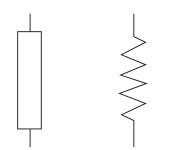Basic electricity:1.5 Resistance
1.5 Resistance
Resistance is defined as the property of a substance due to which it opposes (or restricts) the flow of electricity (i.e., electrons) through it. The third factor that plays a role in an electrical circuit. All material impedes the flow of electrical current to some extent. The amount of resistance depends upon the composition, length, cross-section, and temperature of the resistive material. As a rule of thumb, the resistance of a conductor increases with an increase of length or a decrease of the cross-section. Resistance is designated by the symbol "R". The unit of measurement for resistance is ohms (Ω).
Conductors and Insulators
Metals (as a class), acids and salts solutions are good conductors of electricity. Amongst pure metals, ilver, copper and aluminium are very good conductors in the given order.Due to the presence of a large number of free or loosely-attached electrons in their atoms, these vagrant electrons assume a directed motion on the application of an electric potential difference. These electrons while flowing pass through the molecules or the atoms of the conductor, collide and other atoms and electrons, thereby producing heat.
Those substances which offer relatively greater difficulty or hindrance to the passage of these electrons are said to be relatively poor conductors of electricity like bakelite, mica, glass, rubber, PVC (polyvinyl chloride) and dry wood etc. Amongst good insulators can be included fibrous substances such as paper and cotton when dry, mineral oils free from acids and water, ceramics like hard porcelain and asbestos and many other plastics besides PVC It is helpful to remember that electric friction is similar to friction in mechanical terms.
Resistance circuit symbols
Resistance is usually indicated symbolically on an electrical drawing in one of two ways. An unfilled rectangle is commonly used. A zigzag line may also be used.
Resistance can be in the form of various components. A resistor may be placed in the circuit, or the circuit might contain other devices that have resistance.
Units of measurement for resistance
The following chart reflects special prefixes that are commonly used when dealing with values of resistance:
| Prefix | Symbol | Decimal |
|---|---|---|
| 1 kiloohm | 1 kΩ | 1000 Ω |
| 1 milliohm | 1 mΩ | 1/1000 Ω |
| 1 microohm | 1 μΩ | 1/1,000,000 Ω |
